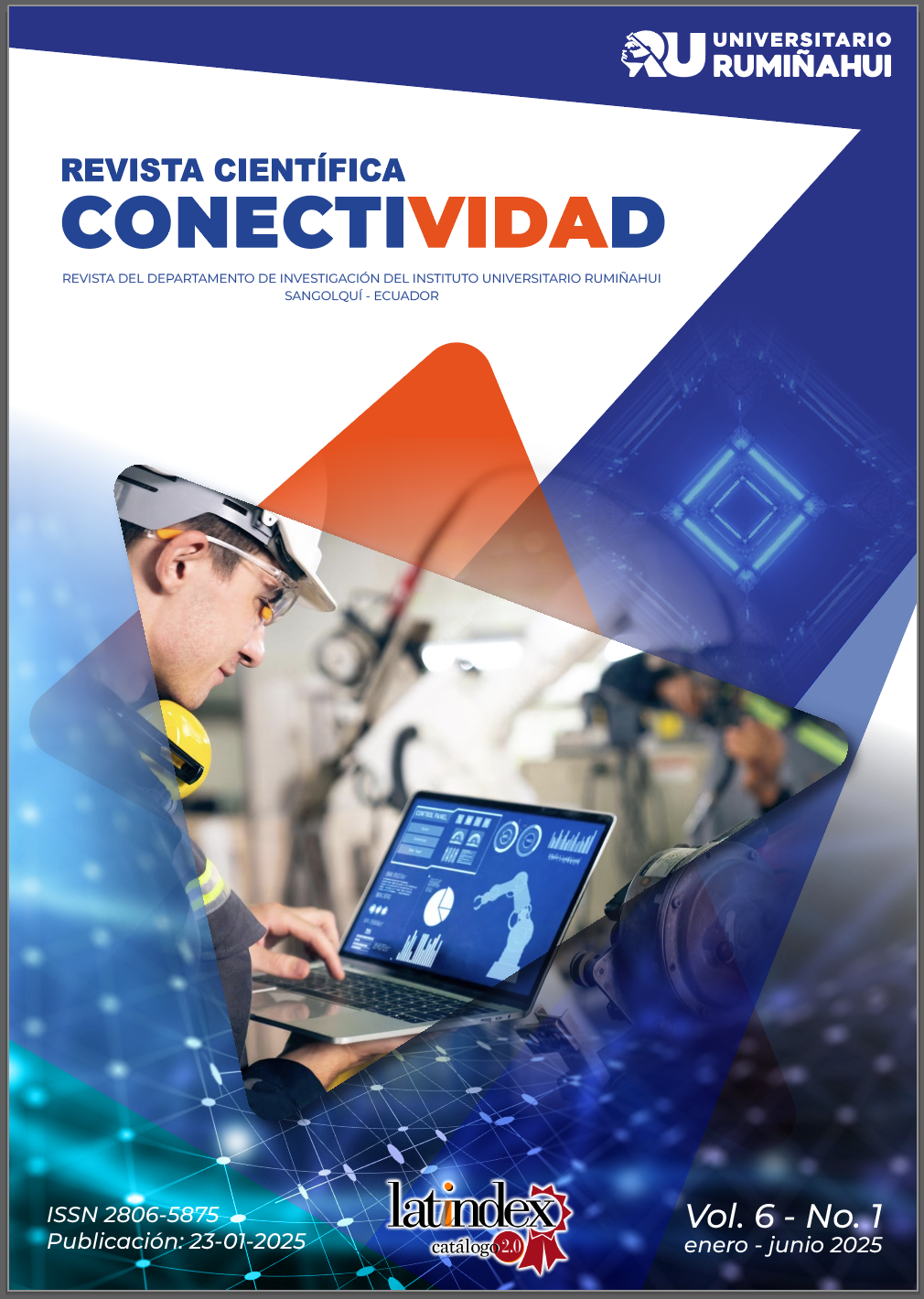Methodology for the creation of virtual learning environments for the subject Automotive Mechanics in Higher Education
DOI:
https://doi.org/10.37431/conectividad.v6i1.226Keywords:
Virtual learning, Virtual learning environments, Automotive mechanics, Higher education, Teaching and learning methodologyAbstract
This article discusses the methodology for the creation of virtual learning environments (VLEs) for automotive mechanics in higher education, emphasizing the need to integrate technological and pedagogical strategies for optimal learning. The introduction highlights the importance of VLEs in the digital age, considering the COVID-19 experience and the potential of virtual reality (VR), the technology acceptance model (TAM) and other pedagogical strategies. The methodology, based on a systematic review of 30 articles from indexed databases, employed specific keywords and the PRISMA method to select and analyze relevant studies. The results and discussion revealed the predominance of project-based learning (23%) and gamification (13%), but also the need for further integration of realistic simulations (10%), VR (16.6%) and learning management platforms (LMS) (20%) adapted to automotive mechanics. A gap was identified in research on interface usability (6.6%) and accessibility (10%), as well as in rigorous evaluation of the impact of VLEs on academic performance. Finally, the conclusion emphasizes the importance of hands-on learning in automotive mechanics, highlighting the need for EVAs to replicate the sensory experience of the workshop, complementing, not replacing, actual practice.
References
Benis, A., Nelke, S. A., & Winokur, M. (2021). Training the Next Industrial Engineers and Managers about Industry 4.0: A Case Study about Challenges and Opportunities in the COVID-19 Era. Sensors, 21(9), 2905. https://doi.org/10.3390/S21092905 DOI: https://doi.org/10.3390/s21092905
Durrani, M. (2020). Debate style lecturing to engage and enrich resident education virtually. Medical Education, 54(10), 955-956. https://doi.org/10.1111/MEDU.14217 DOI: https://doi.org/10.1111/medu.14217
Ershad, N. F., Mehrjardi, R. T., & Ehsani, M. (2019). Electro-Mechanical EV Powertrain With Reduced Volt-Ampere Rating. IEEE Transactions on Vehicular Technology, 68(1), 224-233. https://doi.org/10.1109/TVT.2018.2881385 DOI: https://doi.org/10.1109/TVT.2018.2881385
Fussell, S. G., & Truong, D. (2021). Using virtual reality for dynamic learning: an extended technology acceptance model. Virtual Reality, 1-19. https://doi.org/10.1007/S10055-021-00554-X DOI: https://doi.org/10.1007/s10055-021-00554-x
Ho, I. M. K., Cheong, K. Y., & Weldon, A. (2021). Predicting student satisfaction of emergency remote learning in higher education during COVID-19 using machine learning techniques. PLOS ONE, 16(4), 1-27. https://doi.org/10.1371/JOURNAL.PONE.0249423 DOI: https://doi.org/10.1371/journal.pone.0249423
Khan, S., Kambris, M. E. K., & Alfalahi, H. (2021). Perspectives of University Students and Faculty on remote education experiences during COVID-19- a qualitative study. Education and Information Technologies, 1-29. https://doi.org/10.1007/S10639-021-10784-W DOI: https://doi.org/10.1007/s10639-021-10784-w
Kruger, K., Wolff, K., & Cairncross, K. (2021). Real, virtual, or simulated: Approaches to emergency remote learning in engineering. Computer Applications in Engineering Education. https://doi.org/10.1002/CAE.22444 DOI: https://doi.org/10.1002/cae.22444
Kumar, A., & Mantri, A. (2021). Evaluating the attitude towards the intention to use ARITE system for improving laboratory skills by engineering educators. Education and Information Technologies, 1-30. https://doi.org/10.1007/S10639-020-10420-Z DOI: https://doi.org/10.1007/s10639-020-10420-z
Kuusinen, K., & Albertsen, S. (2019). Industry-academy collaboration in teaching DevOps and continuous delivery to software engineering students: towards improved industrial relevance in higher education. 23-27. https://doi.org/10.1109/ICSE-SEET.2019.00011 DOI: https://doi.org/10.1109/ICSE-SEET.2019.00011
Mijailović, Đ., Đorđević, A., Stefanovic, M., Vidojević, D., Gazizulina, A., & Projović, D. (2021). A Cloud-Based with Microcontroller Platforms System Designed to Educate Students within Digitalization and the Industry 4.0 Paradigm. Sustainability, 13(22), 12396. https://doi.org/10.3390/SU132212396 DOI: https://doi.org/10.3390/su132212396
Pereira, N. L., Mendes, A., Spanhol, F. J., & Lunardi, G. M. (2019). Good practices in virtual teaching and learning environments: a systematic literature review. Educational Review, 35. https://doi.org/10.1590/0102-4698214739 DOI: https://doi.org/10.1590/0102-4698214739
Prisacaru, A., Gromala, P. J., Han, B., & Zhang, G. Q. (2022). Degradation Estimation and Prediction of Electronic Packages Using Data-Driven Approach. IEEE Transactions on Industrial Electronics, 69(3), 2996-3006. https://doi.org/10.1109/TIE.2021.3068681 DOI: https://doi.org/10.1109/TIE.2021.3068681
Race, A., Jesus, M. De, Beltran, R. S., & Zavaleta, E. S. (2021). A comparative study between outcomes of an in-person versus online introductory field course. Ecology and Evolution, 11(8), 3625-3635. https://doi.org/10.1002/ECE3.7209 DOI: https://doi.org/10.1002/ece3.7209
Turnbull, D., Chugh, R., & Luck, J. (2021). Transitioning to E-Learning during the COVID-19 pandemic: How have Higher Education Institutions responded to the challenge? Education and Information Technologies, 26(5), 1-19. https://doi.org/10.1007/S10639-021-10633-W DOI: https://doi.org/10.1007/s10639-021-10633-w
Urrea, C., Garrido, F., & Kern, J. A. (2021). Design and Implementation of Intelligent Agent Training Systems for Virtual Vehicles. Sensors, 21(2), 492. https://doi.org/10.3390/S21020492 DOI: https://doi.org/10.3390/s21020492
Vincke, B., Florez, S. R. R., & Aubert, P. (2021). An Open-Source Scale Model Platform for Teaching Autonomous Vehicle Technologies. Sensors, 21(11), 3850. https://doi.org/10.3390/S21113850 DOI: https://doi.org/10.3390/s21113850
Published
How to Cite
Issue
Section
License
Copyright (c) 2025 Instituto Superior Tecnológico Universitario Rumiñahui

This work is licensed under a Creative Commons Attribution-NonCommercial 4.0 International License.
The originals published in the electronic edition under the first publication rights of the journal belong to the Instituto Superior Tecnológico Universitario Rumiñahui; therefore, it is necessary to cite the source in any partial or total reproduction. All the contents of the electronic journal are distributed under a Creative Commons Attribution-Noncommercial 4.0 International (CC-BY-NC 4.0) license.







2.png)





